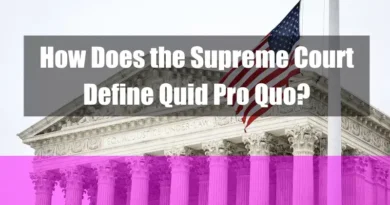Sex or Gender-Based Quid Pro Quo Harassment
Takeaways
| Key Points |
|---|
| Sex or gender-based quid pro quo harassment occurs when employment opportunities or benefits are contingent on submitting to unwelcome sexual advances or conduct, reflecting a transactional power imbalance often rooted in societal gender norms. |
| This harassment can be explicit, such as overt demands for sexual favors tied to job security, or implicit, involving subtle pressures like suggestive comments or implied career consequences. |
| Victims, who may include women, men, and non-binary individuals, face significant emotional and professional consequences, with marginalized groups often experiencing compounded impacts due to intersectional discrimination. |
| Title VII of the Civil Rights Act of 1964 prohibits such harassment as a form of sex discrimination, with the EEOC playing a key role in enforcement and providing guidance to employers to foster safe workplaces. |
| State laws, such as those in California and New York, often expand protections beyond federal standards, underscoring the importance of proactive workplace policies and training to address this pervasive issue. |
Introduction
Definition of Sex or Gender-Based Quid Pro Quo Harassment
Sex or gender-based quid pro quo harassment is a specific form of workplace discrimination where an individual’s employment opportunities or benefits are contingent upon their submission to unwelcome sexual advances or conduct. The term “quid pro quo” is Latin for “this for that,” which aptly captures the transactional nature of this harassment: an offer of job security, promotion, or other work-related benefits in exchange for sexual favors.
Unlike other forms of harassment, quid pro quo harassment directly ties the victim’s compliance with sexual demands to tangible employment outcomes, making it a particularly insidious form of coercion.
Distinction between General Quid Pro Quo Harassment and Gender-Based Forms
While general quid pro quo harassment can involve any inappropriate exchange of benefits when it is sex or gender-based, the harassment specifically revolves around sexual demands or conduct linked to the victim’s gender.
This type of harassment often targets individuals based on their gender or sexual identity. It is rooted in power dynamics that exploit societal gender norms and expectations.
The perpetrator typically holds a position of authority, which they leverage to pressure or coerce the victim into compliance. Unlike broader definitions of quid pro quo, gender-based forms specifically involve conduct of a sexual nature, making them not only a violation of workplace policies but also a form of sex discrimination under the law.
Characteristics of Sex or Gender-Based Quid Pro Quo Harassment
Explicit vs. Implicit Harassment Tactics
Sex or gender-based quid pro quo harassment can manifest in both explicit and implicit forms. Explicit harassment is direct and unmistakable. For instance, a supervisor might overtly demand sexual favors in exchange for a raise or promotion. An example could be a manager telling an employee, “If you want to keep your job, you need to meet me outside of work.”
Such clear-cut cases are easier to identify but not necessarily easier to resolve, as they often come with implied threats that discourage victims from coming forward.
Implicit harassment, on the other hand, is more subtle. It may involve suggestive comments or actions that create an environment where the employee feels pressured to comply with sexual demands to avoid negative consequences. For example, a boss might consistently hint that attending social events outside of work, which have a sexual undertone, is necessary for career advancement.
Implicit harassment can be more challenging to prove because it often relies on the victim’s interpretation of the harasser’s intentions, making it essential for organizations to foster environments where employees feel safe reporting even the subtlest forms of harassment.

Examples of Unwelcome Advances and Their Consequences
Unwelcome advances in sex or gender-based quid pro quo harassment can take many forms, from verbal propositions to physical actions.
For example, a supervisor might ask an employee to go out on a date and imply that saying no would negatively affect their job prospects. If the employee refuses, they might be suddenly excluded from essential projects, receive poor performance reviews, or be denied promotions.
Another example could involve a boss making repeated inappropriate comments about an employee’s appearance or asking them to dress in a sexually suggestive way. The implicit message is that compliance will be rewarded, while refusal will lead to negative job consequences.
The consequences for victims of quid pro quo harassment can be severe, ranging from emotional distress and anxiety to the loss of job opportunities and even forced resignation.
Gender and Sex Dynamics in Quid Pro Quo Harassment

How Gender and Sex Influence Harassment Dynamics
Gender and sex are central to understanding the dynamics of quid pro quo harassment. Historically, women have been more likely to experience this form of harassment due to entrenched gender roles and stereotypes that portray women as submissive or available to those in power.
However, men and non-binary individuals can also be victims, although their experiences may be less frequently reported due to social stigma or fear of not being taken seriously.
The gender of the harasser and the victim can influence how the harassment is perceived and addressed. For instance, male victims might be less likely to report harassment due to fears of emasculation or not being believed.
Similarly, non-binary and transgender individuals may face unique challenges, such as harassment tied to their gender identity or expression, which complicates their ability to seek recourse.
Differences in How Men, Women, and Non-Binary Individuals Experience Quid Pro Quo Harassment
The experiences of quid pro quo harassment can vary significantly across different gender identities. Women are more likely to face harassment that is overtly sexual in nature, with demands that align with traditional gender stereotypes. For example, a female employee might be expected to flirt with clients or dress provocatively to secure business deals under the implicit or explicit understanding that refusal would harm her career.
Men, while less frequently reported as victims, may experience harassment in ways that challenge their masculinity, such as being coerced into sexual situations to prove their loyalty or to avoid ridicule.
This type of harassment can be particularly damaging as it taps into deep-seated cultural norms about male dominance and control.
Non-binary and transgender individuals might face harassment that is both sexual and related to their gender identity. For instance, they might be pressured to conform to traditional gender expressions or be subjected to invasive questions about their bodies as a condition of their employment.
The intersection of gender identity with quid pro quo harassment adds layers of complexity, as victims may struggle to find language that accurately describes their experiences or fear retaliation based on their gender nonconformity.
Intersectionality: Impact of Race, Sexual Orientation, and Other Identities
Intersectionality is critical in how individuals experience and respond to quid pro quo harassment. Victims who belong to multiple marginalized groups—such as women of color, LGBTQ+ individuals, or those with disabilities—often face compounded forms of discrimination that exacerbate the effects of harassment. For example, a Black woman might experience harassment that is both sexual and racially motivated, with derogatory comments that reference both her gender and race.
LGBTQ+ individuals, particularly those who are non-binary or transgender, may encounter harassment that targets both their sexual orientation and gender identity. This can include being coerced into hiding their true identity in exchange for career opportunities or being subjected to inappropriate questions or comments about their private lives as a condition for employment benefits.
These intersectional dynamics mean that the impact of quid pro quo harassment is not uniform; it varies depending on the specific identities of the victim.
Understanding these complexities is crucial for creating effective policies and support systems that address the full spectrum of harassment experiences.
Power Imbalances and Gender Norms in the Workplace
Power imbalances and gender norms are central to the perpetuation of quid pro quo harassment. Traditional gender roles often place women in subordinate positions relative to men, reinforcing power dynamics that make harassment more likely. For instance, in male-dominated industries, women may feel pressured to conform to sexist norms to advance their careers, making them more vulnerable to quid pro quo harassment.
Conversely, men in positions of power may feel entitled to make sexual demands of their subordinates, viewing it as an extension of their authority. These gender norms are deeply embedded in many workplace cultures, making it challenging to address harassment without confronting the broader societal issues that sustain it.
Non-binary and transgender individuals face unique challenges related to power dynamics and gender norms. They may be marginalized within the workplace, making them more vulnerable to harassment from those in positions of authority. Moreover, the lack of clear policies protecting their rights can leave them with few avenues for recourse.
Legal Framework

Overview of Title VII of the Civil Rights Act of 1964
Title VII of the Civil Rights Act of 1964 is a cornerstone of U.S. employment law, prohibiting discrimination based on race, color, religion, sex, and national origin. Under Title VII, sex-based discrimination includes quid pro quo harassment, where submission to sexual conduct is made a condition of employment.
The law provides a legal framework for victims to seek redress and holds employers accountable for failing to prevent or address such harassment.
Interpretation of Sex or Gender-Based Quid Pro Quo Harassment under Federal Law
Federal law interprets sex or gender-based quid pro quo harassment as a violation of Title VII when an employee is subjected to unwelcome sexual advances or conduct as a condition of their employment. The U.S. Equal Employment Opportunity Commission (EEOC) enforces Title VII, investigating complaints and taking legal action against employers who fail to comply with the law.
The legal standard for proving quid pro quo harassment typically involves demonstrating that the victim’s employment was conditioned on their submission to sexual demands and that they suffered a tangible employment action as a result.
State Laws and Variations
State laws can vary significantly in how they address sex or gender-based quid pro quo harassment. For example, states like California and New York have more stringent laws beyond the federal protections offered by Title VII. In California, the Fair Employment and Housing Act (FEHA) provides robust protections against sexual harassment, including quid pro quo harassment. The FEHA mandates that employers take reasonable steps to prevent and correct wrongful behavior, and it also lowers the threshold for what constitutes harassment, making it easier for victims to prove their cases.
New York State Human Rights Law (NYSHRL) similarly expands protections, eliminating the requirement that harassment must be “severe or pervasive” to be actionable. This broader standard reflects an understanding that even a single instance of quid pro quo harassment can have significant consequences for the victim.
New York also has specific employer training requirements and policies to prevent harassment.
Role of the Equal Employment Opportunity Commission (EEOC) in Enforcement
The EEOC plays a crucial role in enforcing federal laws against sex or gender-based quid pro quo harassment. When a victim files a complaint, the EEOC investigates the allegations and determines whether sufficient evidence supports the claim. Suppose the EEOC finds that the employer has violated Title VII. In that case, it can seek remedies for the victim, including back pay, reinstatement, and damages for emotional distress.
The EEOC also provides guidance to employers on how to prevent and address harassment in the workplace. This includes recommending that employers establish anti-harassment policies, train employees and managers regularly, and create effective reporting mechanisms that allow victims to come forward without fear of retaliation.
Employer Liability and Responsibilities

Employers are legally obligated to prevent and address sex or gender-based quid pro quo harassment in the workplace. Under Title VII of the Civil Rights Act, employers can be held liable if they fail to take appropriate measures to prevent harassment or inadequately respond to complaints.
Liability may arise when an employer neglects to establish clear anti-harassment policies or does not train employees and managers sufficiently. Moreover, suppose an employer knows or should have known about the harassment and fails to act. In that case, they may be held responsible for the consequences.
Employers must implement effective policies that define quid pro quo harassment and outline procedures for reporting incidents. These policies must be well-communicated and accessible to all employees. Additionally, employers should establish a confidential and non-retaliatory reporting system that encourages victims to come forward.
When a complaint is received, employers must conduct a prompt, thorough, and impartial investigation to determine the facts and take corrective action. This can include disciplinary measures against the harasser, including termination, to ensure a safe working environment.
Reporting and Legal Recourse

Victims of sex or gender-based quid pro quo harassment have several avenues for reporting and seeking legal recourse. Initially, victims should report the harassment internally, following their employer’s procedures. Suppose the issue is unresolved or the victim feels unsafe reporting within their organization. In that case, they can file a complaint with the Equal Employment Opportunity Commission (EEOC). The EEOC investigates claims and may pursue legal action against the employer if violations are found.
Legal recourse for victims can include monetary compensation for lost wages, emotional distress, and, in some cases, punitive damages designed to penalize the employer. Additionally, victims may seek reinstatement to their jobs if they were wrongfully terminated.
State laws may also provide additional protections and avenues for recourse, often with shorter timelines for filing complaints than federal regulations.
FAQ
What is sex discrimination quid pro quo?
Sex discrimination quid pro quo occurs when employment decisions are explicitly tied to compliance with sexual requests, resulting in unequal treatment based on sex. This form of harassment violates equal opportunity principles by conflating professional advancement with the acceptance of unwanted sexual behavior.
What is gender bias quid pro quo?
Gender bias quid pro quo happens when individuals in power condition job benefits on adherence to stereotypical gender norms. This practice creates an environment where employment decisions are influenced by gender bias, limiting opportunities for those who do not conform to expected gender behaviors.
What is quid pro quo sexual exploitation?
Quid pro quo sexual exploitation involves manipulating employees by promising career advancement or benefits in exchange for sexual favors. This exploitation abuses the inherent power dynamics within the workplace, compromising professional integrity and contributing to a hostile environment.
What is quid pro quo employment retaliation?
Quid pro quo employment retaliation occurs when an employee faces punitive actions, such as demotion or dismissal, after refusing sexual advances or reporting harassment. This retaliatory behavior further victimizes the individual and discourages others from speaking out against similar misconduct.
What is quid pro quo unwelcome sexual advances?
Quid pro quo unwelcome sexual advances are unsolicited sexual demands that are directly linked to employment benefits or the avoidance of negative consequences. Such advances breach the principles of consensual workplace interactions and foster an environment of exploitation and inequity.
What is quid pro quo gender misconduct?
Quid pro quo gender misconduct refers to behaviors that misuse gender dynamics by tying professional opportunities to compliance with inappropriate gender-related demands. This misconduct undermines fair employment practices by introducing discriminatory criteria into merit-based decisions.
What is a quid pro quo sexual proposition?
A quid pro quo sexual proposition involves offering employment benefits in exchange for sexual favors, effectively linking professional success to sexual compliance. This proposition abuses the power structure in the workplace, creating an environment where the threat of adverse consequences compromises consent.
What is quid pro quo gender favoritism?
Quid pro quo gender favoritism occurs when preferential treatment is granted based on conformity to specific gender expectations. This bias distorts objective evaluation processes and reinforces discriminatory practices by associating job rewards with gender compliance rather than merit.
What is quid pro quo sex-based exploitation?
Quid pro quo sex-based exploitation is a form of harassment where an individual’s sexual characteristics are leveraged to secure job benefits. This exploitation depends on an unequal power dynamic that forces employees to compromise between their professional aspirations and personal integrity.
What is a quid pro quo sexual harassment policy?
A quid pro quo sexual harassment policy is a comprehensive set of guidelines that defines, prevents, and addresses incidents where job benefits are conditioned on sexual compliance. It provides clear procedures for reporting, investigating, and remedying such behavior to maintain a respectful and safe work environment.
What is quid pro quo gender harassment training?
Quid pro quo gender harassment training is designed to educate employees and management on recognizing and preventing harassment that exploits gender-based power dynamics for professional gain. This training emphasizes legal standards, respectful interactions, and cultivating an inclusive workplace culture that actively discourages discriminatory practices.









